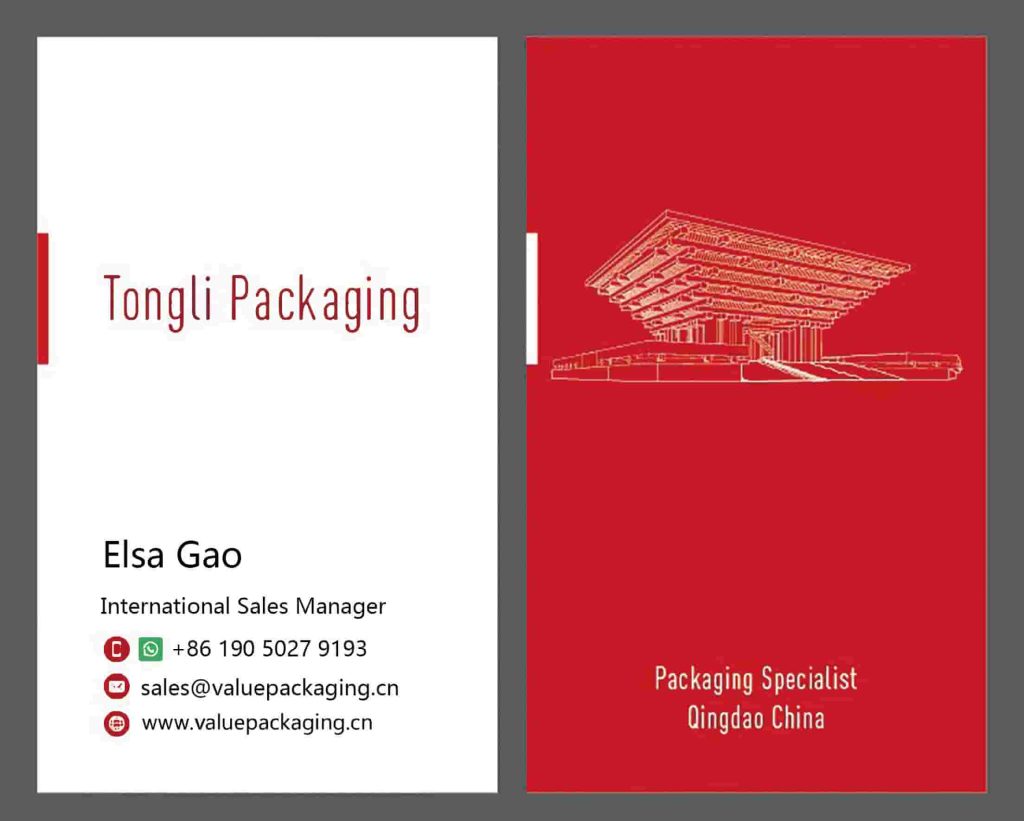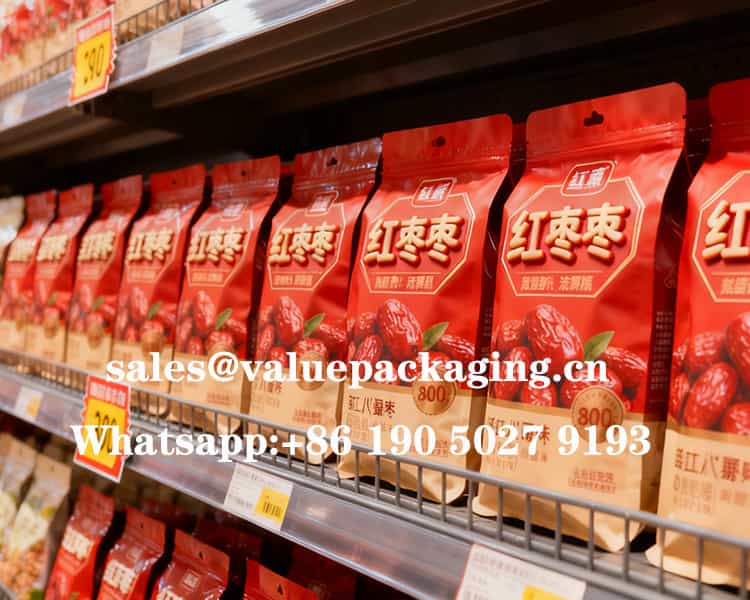
Flat Bottom Pouches are increasingly popular in the premium food and coffee packaging market. This pouch style combines the advantages of stand-up and box pouches, offering both excellent shelf presentation and strong functionality. The flat base allows the bag to stand firmly and neatly on display shelves, while its side gussets and wide opening provide larger capacity and easier filling.
Constructed from high barrier laminated films, flat bottom bags ensure outstanding protection against oxygen, moisture, and light, keeping products fresh during filling, transport, and storage. The sturdy structure also supports heavier contents without compromising shape or stability.
In addition to their practicality, flat bottom pouches offer superior branding potential. The five printable panels – front, back, two sides, and bottom – provide ample space for creative artwork and detailed product information. This makes the package not only functional but also highly eye-catching, helping brands stand out on retail shelves.
Available in compostable, recyclable, or traditional materials, flat bottom pouches are a versatile choice for brands seeking premium, sustainable packaging solutions that combine durability, aesthetics, and eco-conscious performance.
As a well-known flexible converter located in Qingdao, China, we are making the best use of the packaging film materials in the market, listed below.
- fossil chemical polymer films
- Aluminum foil metal sheet
- vacuum metalized film materials
- Ceramic film substrates
- plant-based biopolymer materials
- biodegradable film materials
- compostable substrate films
- Fully recyclable substrate films
In this post, we will analyze the exact foil materials of this 250-gram Chinese He Tian dates box bottom bags, hoping it could serve as a reference for your products.
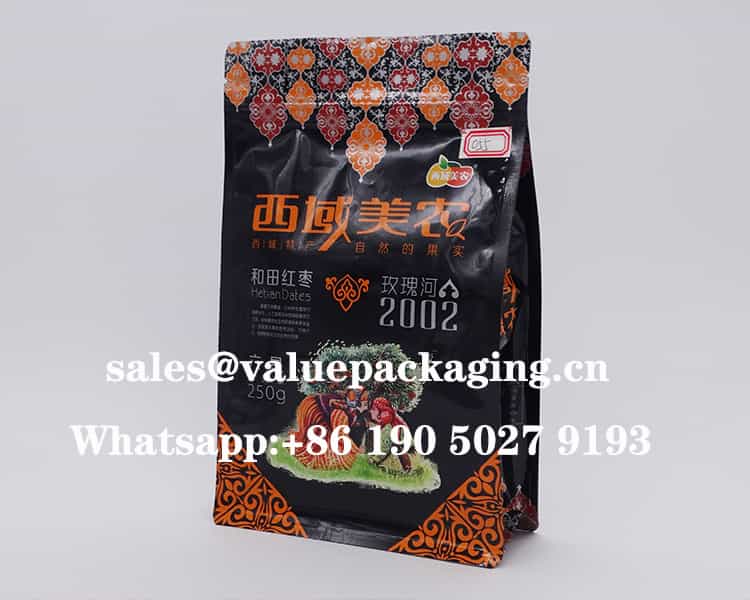
Packaging Foil Materials
The figure below shows the composition structure of this laminated foil material used to convert this flat bottom Chinese He Tian dates bag.

It is made of triplex layers, with the outside PET film 12 microns working as the print substrate film, the VMPET film 12 microns working as the middle barrier layer, and finally, the LDPE film working as the inner sealing layer. The thickness of the LDPE film should be adjusted to suit the requirements of 250g Chinese dates
Next, let’s get into a deeper understanding of each substrate film material.
PET Film

PET Film is one of the most commonly used printing substrates in flexible packaging sachets. With great optical clarity, high gloss, good chemical resistance, stable mechanical strength, excellent dimensional stability, and great printability, it can present the customer artwork print in great quality and also provide great mechanical strength to the final package.
The most commonly used thickness of PET film applied in the flexible packaging industry is 12 microns, which equals 0.48 gauge. So, whenever you see PET12 or 0.48 g PET, you will know they mean the same thing.
VMPET Film
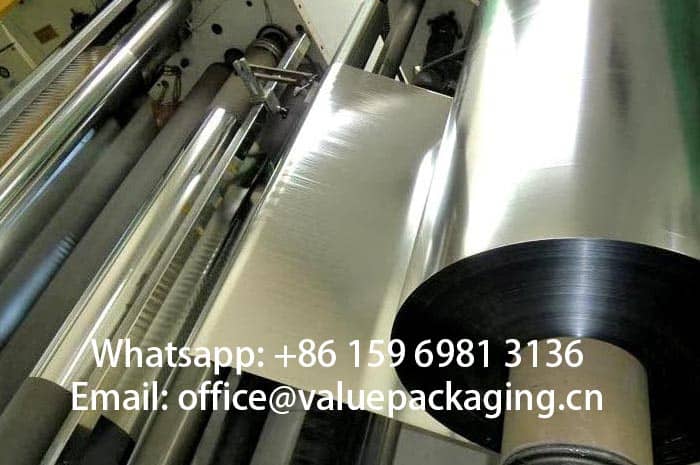
VMPET film is short for vacuum metalized polyester film. It is achieved under vacuum conditions by depositing a thin layer of aluminum atoms onto the surface of a PET (polyester) film substrate and finally realizing a bright metallic film that is widely used in flexible packaging and standup pouch packages.
LDPE
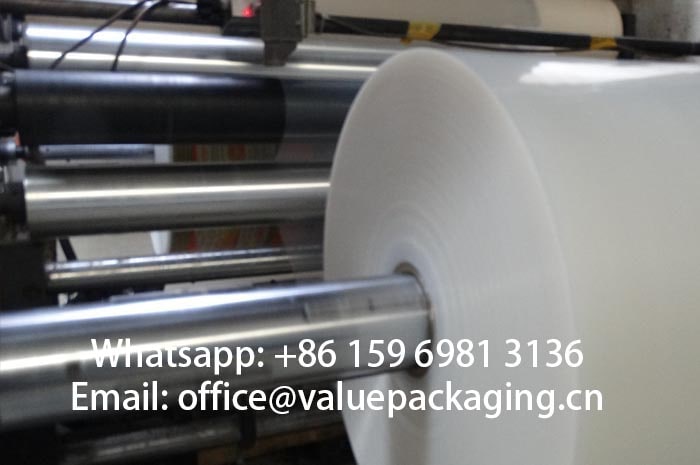
LDPE means low-density polyethylene film, the most used inner sealing layer for standing juice bags. LDPE is also lightweight, easy to fabricate, and has good chemical and impact resistance. LDPE is recyclable and reusable, making it a popular alternative to traditional plastic. LDPE is nontoxic, non-contaminating, and has high break resistance. Most importantly, LDPE membrane can be modified against the requirement of specific products and finalize the package with great seal strength and protection. The thickness of the LDPE membrane film will be decided against the particular application.
These 3 layers are bonded together into a finished laminated foil material under the dry lamination or solvent-free lamination process. Usually, we describe the finished laminate as PET12/VMPET12/LDPE foil.
Great Standup Effect
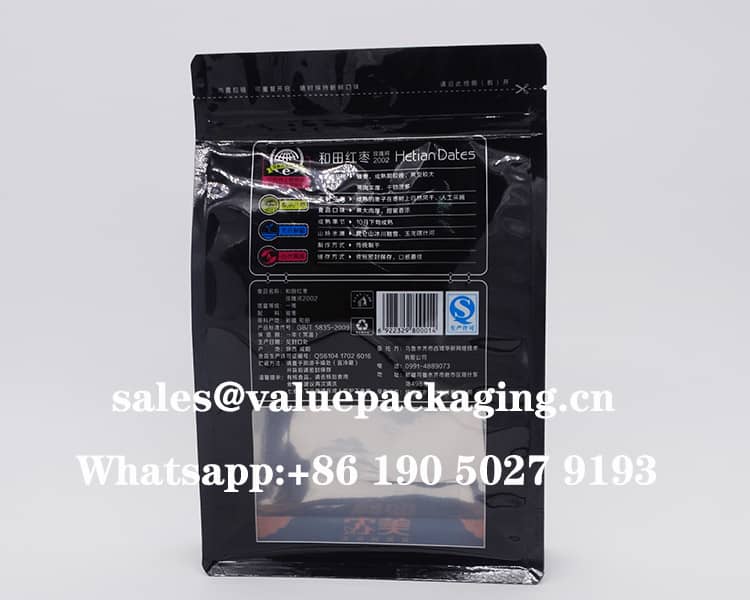
Excellent Stand-Up Effect
- The eight-side seal structure provides a more stable base, preventing the bag from tipping over. It stands firmly on shelves or tables, offering better display appeal.
- The rigid structure keeps the bag upright without collapsing, maintaining a clean and premium appearance.
Advantages of the Transparent Window
- Clear product visibility – Consumers can directly see the high-quality Xinjiang red dates inside, increasing trust and confidence in the product.
- Enhanced shelf appeal – The visible natural ingredients attract attention and stimulate purchase desire more effectively than fully opaque packaging.
- Convenient for daily use – The transparent window allows customers to check the remaining quantity without opening the bag.
Excellent Airtight Property for Zipper lock

This single-track plastic zipper is applied onto the doy-pack. The zipper will be tightly sealed with the inner LDPE film of the pouch. It enables the package to be repeatedly opened and closed with great airtight properties. The platinum chips can be kept fresh for a long time after being opened.
Serious measures are taken in our QC work to check the airtight properties for the inner zipper, and you are advised to have a further understanding of this test progress through the video below.
Mechanical Property
Tensile strength
The package will protect platinum chips in filling, transit, and distribution. Under the emergency circumstances of unexpected shock in delivery or packages falling off the goods shelf, the package will never be allowed to break.
This reinforced laminated foil is achieved with great mechanical strength, with some standard items as below.
- Tensile Strength
- Sealing Strength
- Anti-puncture Strength
- Burst Impact Strength
- Anti-pressure Property
The above tests are performed against each order based on customer requirements, and you may check the exact values of this foil material in the Technical Date Sheet part of this post.
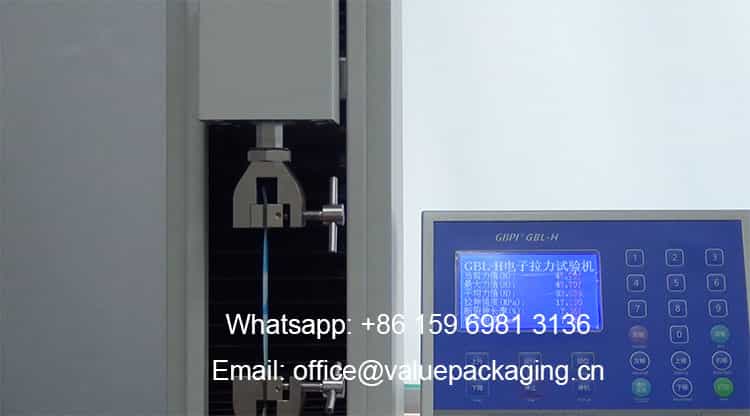
Drop Test
In our daily QC work, there is a more reliable method to check if the bag strength is enough to meet the final requirements of various customers. We perform a drop test against each order, of course, the standard for this drop test should be decided against customer needs.
Here, we are going to fill 1000 grams of rice into this bag, perform the drop test from 1.6 meters high, 3 times, and check if it breaks.
Barrier Performance
Usually, the barrier performance of a multi-material laminate is evaluated by WVTR (short for water vapor transmission rate) and OTR (Oxygen Transmission Rate). The below table shows the typical value of the WVTR and OTR of the most common substrate films in flexible packaging.
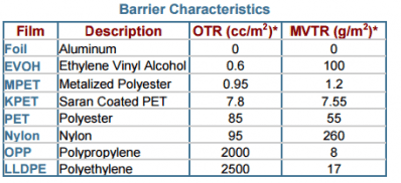
Based on our experience, PET/VMPET/LDPE foil laminate will be able to meet most of the requirements for platinum chips. WVTR (short for water vapor transmission rate) and OTR (Oxygen Transmission Rate) are evaluated for this laminated foil, with typical values listed in the below table.
| Item | Standard | Unit | Typical Value |
| Water Vapor Transimission Rate | ASTM E 96 | g/m2/24hr | 1.25 |
| Oxygen Transmission Rate | ASTM D 372-99 | cc/m2/24hr | 1.36 |
Technical Data Sheet of 250 grams Chinese dates flat bottom pouch
More tests are included in this specification sheet with items available listed as below.
- Yield (grams per square meter)
- Tensile Strength (Mpa)
- Elongation Rate (%)
- Coefficient of friction, short as COF
- Solvents Left (mg/m2 )
- Sealing Strength (N/15mm)
- Sealing Conditions
- Bond Strength (N/15mm)
- Burst Strength (J)
- Anti-Puncture ability (N)
- Drop Test Ability (cm)
- Anti-pressure ability (kgs)
- Water Vapor Transmission Rate (g/m2/24hr)
- Oxygen Transmission Rate (cc/m2/24hr)
More Sustainable Materials Options
With the growing burden of fossil-based polymer waste on our environment, there is an increasing demand for sustainable packaging that supports more eco-friendly business practices. Recent research in the detergent market shows that consumers are increasingly inclined to purchase products that demonstrate a commitment to environmental sustainability.
Compostable Packaging Materials
The compostable packages are based on plant-based fibers like cellulose, or bio-mass like corn starch, cassava, or sugarcane. The resins derived from these resources are usually named bio-polymer, which can break down into inorganic elements under the functions of algae, bacteria, and other microorganisms.
We have developed several compostable foil materials that can be intended for roasted sunflower seeds, with the list below.
- Cellulose/Metallized Cellulose/PLA+PBAT Film
- Metallized Paper/Cellulose/VMPET/PLA+PBAT Film
- Kraft Paper/Metallized Cellulose/PLA+PBAT Film
Fully Recyclable Mono Materials
Compared with the high cost of compostable foil materials, fully recyclable sachets and roll films are rapidly gaining popularity in the market as a more affordable solution for lightweight packaging.
With the continuous improvement of PE film barrier performance, foil laminates can now effectively protect products such as sunflower seeds from moisture. To further enhance barrier properties, a PVA coating can be applied to the surface of LDPE or HDPE films, improving moisture resistance. Additionally, EVOH layers incorporated into biaxially oriented PE film (BOPE) significantly enhance oxygen barrier performance, making it ideal for flexible packaging applications.
If you have any questions or would like to learn more about our juice pouch packaging solutions, please feel free to reach out.
Have a great day!
